CASE STUDY. CASE STUDY. 4. Case Study- The Deterioratin
VerifiedAdded on 2022/10/31
|11
|2944
|5
AI Summary
Contribute Materials
Your contribution can guide someone’s learning journey. Share your
documents today.

Running head: CASE STUDY
Case Study- The Deteriorating Patient
(Hypovolemic shock)
Student Name:
Student Number:
Author Note:
Word Count:1944
Case Study- The Deteriorating Patient
(Hypovolemic shock)
Student Name:
Student Number:
Author Note:
Word Count:1944
Secure Best Marks with AI Grader
Need help grading? Try our AI Grader for instant feedback on your assignments.

1CASE STUDY
The case subject, Kenneth Bradman, is a 67 year old man who has been found to
be admitted to a surgical high dependency unit after a per rectal bleed. In the emergency
department he required a blood transfusion, after which he was transferred to the
Surgical High Dependency Unit for further monitoring of any symptoms of underlying
hypovolemic shock. Hypovolemic shock refers to the severe reduction in the fluid
component of the blood, rendering the heart unable to effectively pump blood to the rest
of the body. This, if not determined and treated at an early stage can be detrimental to
the other organs and gravely affect their functionality (El Ayadi et al., 2016, p.
e0148729). The case subject was kept under observation for any symptoms of atrial
fibrillation as well as the potential incidence of acute kidney failure. Upon neurological
assessment, he was found to be oriented at times and disoriented at other times. His
ECG readings indicated that he was suffering from atrial fibrillation, which was
resolved; however, he was found to show signs of shortness of breath indicated by
mildly elevated respiration rate. He was also observed to have reduced bowel
movements upon abdomen auscultation. The subject was found to have reduced urine
output upon admission, and was administered an indwelling urinary catheter.
The following essay will identify the signs and symptoms of the case subject, determine
the priority medical problem, provide nursing interventions for it and discuss the
psychosocial issue of the case subject.
An individual suffers fromhypovolemic shock when they suddenly lose severe
amounts of blood or other bodily fluids, which reduces the overall volume of the blood
circulating the entire body. This is deemed as a fatal medical complication, as the
organs, from the lack of blood flow through them often suffers from severe hypoxia.
The low oxygen amount in the organs, result in the sudden drop of the overall body
The case subject, Kenneth Bradman, is a 67 year old man who has been found to
be admitted to a surgical high dependency unit after a per rectal bleed. In the emergency
department he required a blood transfusion, after which he was transferred to the
Surgical High Dependency Unit for further monitoring of any symptoms of underlying
hypovolemic shock. Hypovolemic shock refers to the severe reduction in the fluid
component of the blood, rendering the heart unable to effectively pump blood to the rest
of the body. This, if not determined and treated at an early stage can be detrimental to
the other organs and gravely affect their functionality (El Ayadi et al., 2016, p.
e0148729). The case subject was kept under observation for any symptoms of atrial
fibrillation as well as the potential incidence of acute kidney failure. Upon neurological
assessment, he was found to be oriented at times and disoriented at other times. His
ECG readings indicated that he was suffering from atrial fibrillation, which was
resolved; however, he was found to show signs of shortness of breath indicated by
mildly elevated respiration rate. He was also observed to have reduced bowel
movements upon abdomen auscultation. The subject was found to have reduced urine
output upon admission, and was administered an indwelling urinary catheter.
The following essay will identify the signs and symptoms of the case subject, determine
the priority medical problem, provide nursing interventions for it and discuss the
psychosocial issue of the case subject.
An individual suffers fromhypovolemic shock when they suddenly lose severe
amounts of blood or other bodily fluids, which reduces the overall volume of the blood
circulating the entire body. This is deemed as a fatal medical complication, as the
organs, from the lack of blood flow through them often suffers from severe hypoxia.
The low oxygen amount in the organs, result in the sudden drop of the overall body
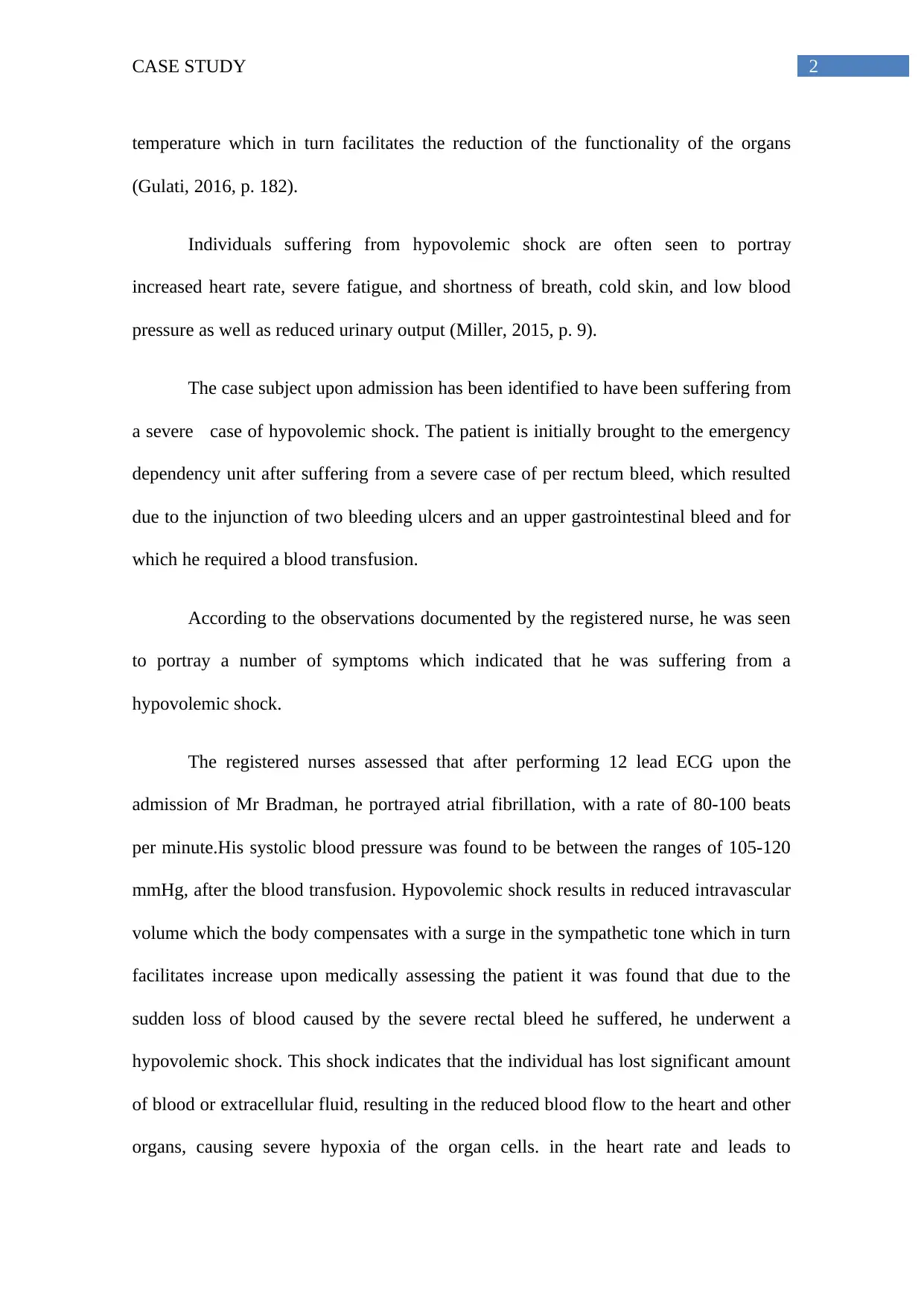
2CASE STUDY
temperature which in turn facilitates the reduction of the functionality of the organs
(Gulati, 2016, p. 182).
Individuals suffering from hypovolemic shock are often seen to portray
increased heart rate, severe fatigue, and shortness of breath, cold skin, and low blood
pressure as well as reduced urinary output (Miller, 2015, p. 9).
The case subject upon admission has been identified to have been suffering from
a severe case of hypovolemic shock. The patient is initially brought to the emergency
dependency unit after suffering from a severe case of per rectum bleed, which resulted
due to the injunction of two bleeding ulcers and an upper gastrointestinal bleed and for
which he required a blood transfusion.
According to the observations documented by the registered nurse, he was seen
to portray a number of symptoms which indicated that he was suffering from a
hypovolemic shock.
The registered nurses assessed that after performing 12 lead ECG upon the
admission of Mr Bradman, he portrayed atrial fibrillation, with a rate of 80-100 beats
per minute.His systolic blood pressure was found to be between the ranges of 105-120
mmHg, after the blood transfusion. Hypovolemic shock results in reduced intravascular
volume which the body compensates with a surge in the sympathetic tone which in turn
facilitates increase upon medically assessing the patient it was found that due to the
sudden loss of blood caused by the severe rectal bleed he suffered, he underwent a
hypovolemic shock. This shock indicates that the individual has lost significant amount
of blood or extracellular fluid, resulting in the reduced blood flow to the heart and other
organs, causing severe hypoxia of the organ cells. in the heart rate and leads to
temperature which in turn facilitates the reduction of the functionality of the organs
(Gulati, 2016, p. 182).
Individuals suffering from hypovolemic shock are often seen to portray
increased heart rate, severe fatigue, and shortness of breath, cold skin, and low blood
pressure as well as reduced urinary output (Miller, 2015, p. 9).
The case subject upon admission has been identified to have been suffering from
a severe case of hypovolemic shock. The patient is initially brought to the emergency
dependency unit after suffering from a severe case of per rectum bleed, which resulted
due to the injunction of two bleeding ulcers and an upper gastrointestinal bleed and for
which he required a blood transfusion.
According to the observations documented by the registered nurse, he was seen
to portray a number of symptoms which indicated that he was suffering from a
hypovolemic shock.
The registered nurses assessed that after performing 12 lead ECG upon the
admission of Mr Bradman, he portrayed atrial fibrillation, with a rate of 80-100 beats
per minute.His systolic blood pressure was found to be between the ranges of 105-120
mmHg, after the blood transfusion. Hypovolemic shock results in reduced intravascular
volume which the body compensates with a surge in the sympathetic tone which in turn
facilitates increase upon medically assessing the patient it was found that due to the
sudden loss of blood caused by the severe rectal bleed he suffered, he underwent a
hypovolemic shock. This shock indicates that the individual has lost significant amount
of blood or extracellular fluid, resulting in the reduced blood flow to the heart and other
organs, causing severe hypoxia of the organ cells. in the heart rate and leads to

3CASE STUDY
peripheral vasoconstriction (Gaieski & Mikkelsen, 2016, p. 17). Thus, the first
observable change is the increase in the diastolic blood pressure and the drop in the
systolic pressure of the individual. This results in the increased hypoxia of the organs
which makes the cells switch to anaerobic metabolism causing lactic acidosis.
Prolonged increase in the sympathetic drive results in tissue ischemia and increases the
incidence of lactic acidosis. If the situation is not detected and treated, this can be highly
fatal for the individual. He was also observed to have cold and clammy skin which is
mainly due to the sudden loss of the blood volume leading to vasoconstriction (Miller,
2015, p. 12).
Upon renal assessment, the patient was found to have reduced urinary output of
about 30mls/hr. for 2 hours. This is mainly due to the significant loss of fluid in the
body, which results in the reduced amount of salt and fluid, often leading to renal
failure. The kidneys attempt to help restore the sodium and water in order to increase
the extracellular volume, which produces undue stress on them, impairing their
concentrating ability. Thus, the overall dehydration of the body, results in the reduced
renal perfusion and leads to the failure in body’s mechanisms, during a hypovolemic
shock (Moore,Hsu & Liu, 2018, p. 139). This also contributes to the decreased urine
formation in the patient. The decreased urine output can lead to the deposition of the
salts in the urinary bladder causing urinary tract infections, which would elevate the
white blood cell count. Hence, considering that upon fluid assessment of Mr Bradman,
his white blood cell count was recorded to be 13.5x 109/L whereas the normal range is
4.3-10.8 x 109/L, him contracting UTI, because of the hypovolemic shock, is a
possibility.
peripheral vasoconstriction (Gaieski & Mikkelsen, 2016, p. 17). Thus, the first
observable change is the increase in the diastolic blood pressure and the drop in the
systolic pressure of the individual. This results in the increased hypoxia of the organs
which makes the cells switch to anaerobic metabolism causing lactic acidosis.
Prolonged increase in the sympathetic drive results in tissue ischemia and increases the
incidence of lactic acidosis. If the situation is not detected and treated, this can be highly
fatal for the individual. He was also observed to have cold and clammy skin which is
mainly due to the sudden loss of the blood volume leading to vasoconstriction (Miller,
2015, p. 12).
Upon renal assessment, the patient was found to have reduced urinary output of
about 30mls/hr. for 2 hours. This is mainly due to the significant loss of fluid in the
body, which results in the reduced amount of salt and fluid, often leading to renal
failure. The kidneys attempt to help restore the sodium and water in order to increase
the extracellular volume, which produces undue stress on them, impairing their
concentrating ability. Thus, the overall dehydration of the body, results in the reduced
renal perfusion and leads to the failure in body’s mechanisms, during a hypovolemic
shock (Moore,Hsu & Liu, 2018, p. 139). This also contributes to the decreased urine
formation in the patient. The decreased urine output can lead to the deposition of the
salts in the urinary bladder causing urinary tract infections, which would elevate the
white blood cell count. Hence, considering that upon fluid assessment of Mr Bradman,
his white blood cell count was recorded to be 13.5x 109/L whereas the normal range is
4.3-10.8 x 109/L, him contracting UTI, because of the hypovolemic shock, is a
possibility.
Secure Best Marks with AI Grader
Need help grading? Try our AI Grader for instant feedback on your assignments.
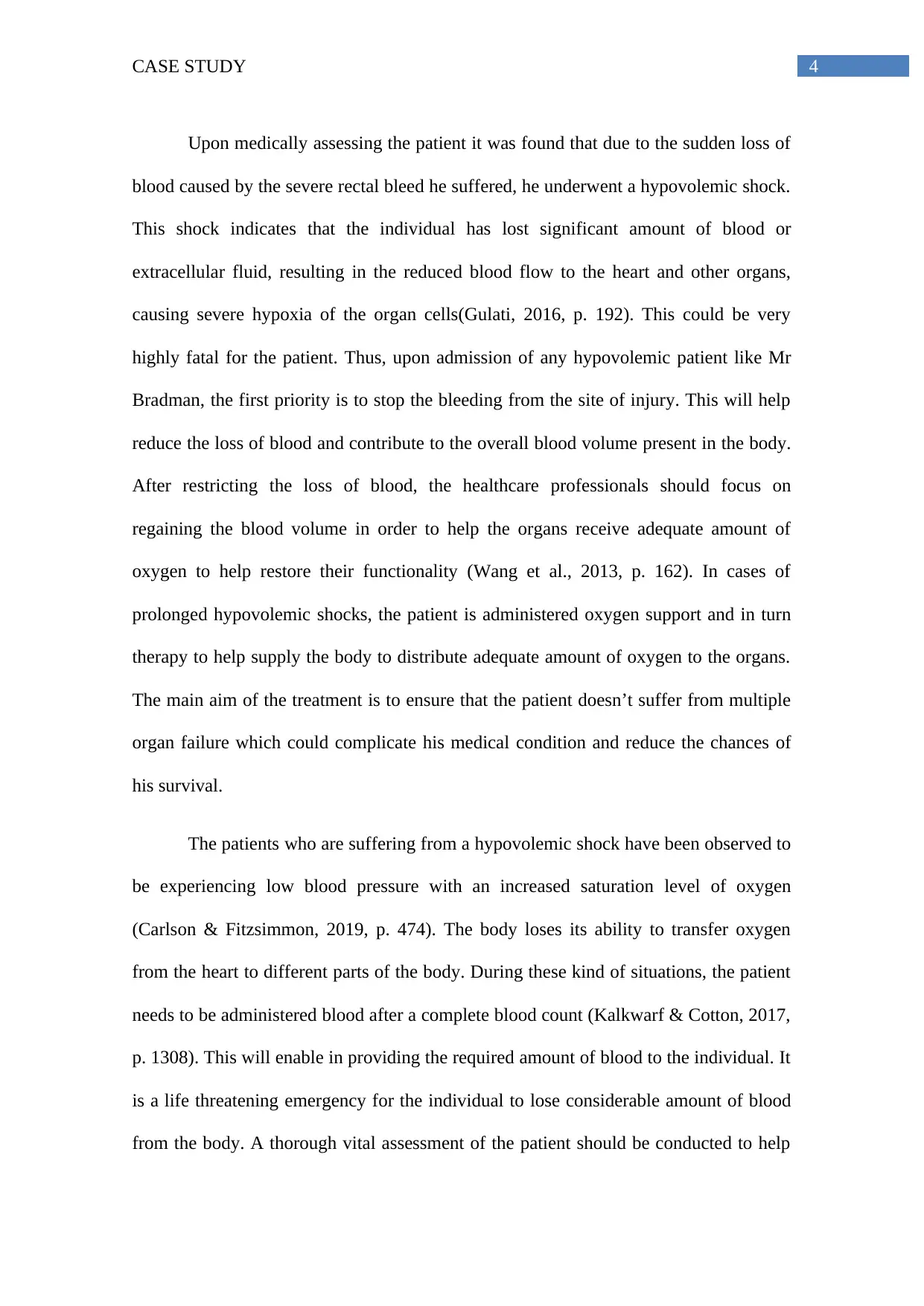
4CASE STUDY
Upon medically assessing the patient it was found that due to the sudden loss of
blood caused by the severe rectal bleed he suffered, he underwent a hypovolemic shock.
This shock indicates that the individual has lost significant amount of blood or
extracellular fluid, resulting in the reduced blood flow to the heart and other organs,
causing severe hypoxia of the organ cells(Gulati, 2016, p. 192). This could be very
highly fatal for the patient. Thus, upon admission of any hypovolemic patient like Mr
Bradman, the first priority is to stop the bleeding from the site of injury. This will help
reduce the loss of blood and contribute to the overall blood volume present in the body.
After restricting the loss of blood, the healthcare professionals should focus on
regaining the blood volume in order to help the organs receive adequate amount of
oxygen to help restore their functionality (Wang et al., 2013, p. 162). In cases of
prolonged hypovolemic shocks, the patient is administered oxygen support and in turn
therapy to help supply the body to distribute adequate amount of oxygen to the organs.
The main aim of the treatment is to ensure that the patient doesn’t suffer from multiple
organ failure which could complicate his medical condition and reduce the chances of
his survival.
The patients who are suffering from a hypovolemic shock have been observed to
be experiencing low blood pressure with an increased saturation level of oxygen
(Carlson & Fitzsimmon, 2019, p. 474). The body loses its ability to transfer oxygen
from the heart to different parts of the body. During these kind of situations, the patient
needs to be administered blood after a complete blood count (Kalkwarf & Cotton, 2017,
p. 1308). This will enable in providing the required amount of blood to the individual. It
is a life threatening emergency for the individual to lose considerable amount of blood
from the body. A thorough vital assessment of the patient should be conducted to help
Upon medically assessing the patient it was found that due to the sudden loss of
blood caused by the severe rectal bleed he suffered, he underwent a hypovolemic shock.
This shock indicates that the individual has lost significant amount of blood or
extracellular fluid, resulting in the reduced blood flow to the heart and other organs,
causing severe hypoxia of the organ cells(Gulati, 2016, p. 192). This could be very
highly fatal for the patient. Thus, upon admission of any hypovolemic patient like Mr
Bradman, the first priority is to stop the bleeding from the site of injury. This will help
reduce the loss of blood and contribute to the overall blood volume present in the body.
After restricting the loss of blood, the healthcare professionals should focus on
regaining the blood volume in order to help the organs receive adequate amount of
oxygen to help restore their functionality (Wang et al., 2013, p. 162). In cases of
prolonged hypovolemic shocks, the patient is administered oxygen support and in turn
therapy to help supply the body to distribute adequate amount of oxygen to the organs.
The main aim of the treatment is to ensure that the patient doesn’t suffer from multiple
organ failure which could complicate his medical condition and reduce the chances of
his survival.
The patients who are suffering from a hypovolemic shock have been observed to
be experiencing low blood pressure with an increased saturation level of oxygen
(Carlson & Fitzsimmon, 2019, p. 474). The body loses its ability to transfer oxygen
from the heart to different parts of the body. During these kind of situations, the patient
needs to be administered blood after a complete blood count (Kalkwarf & Cotton, 2017,
p. 1308). This will enable in providing the required amount of blood to the individual. It
is a life threatening emergency for the individual to lose considerable amount of blood
from the body. A thorough vital assessment of the patient should be conducted to help
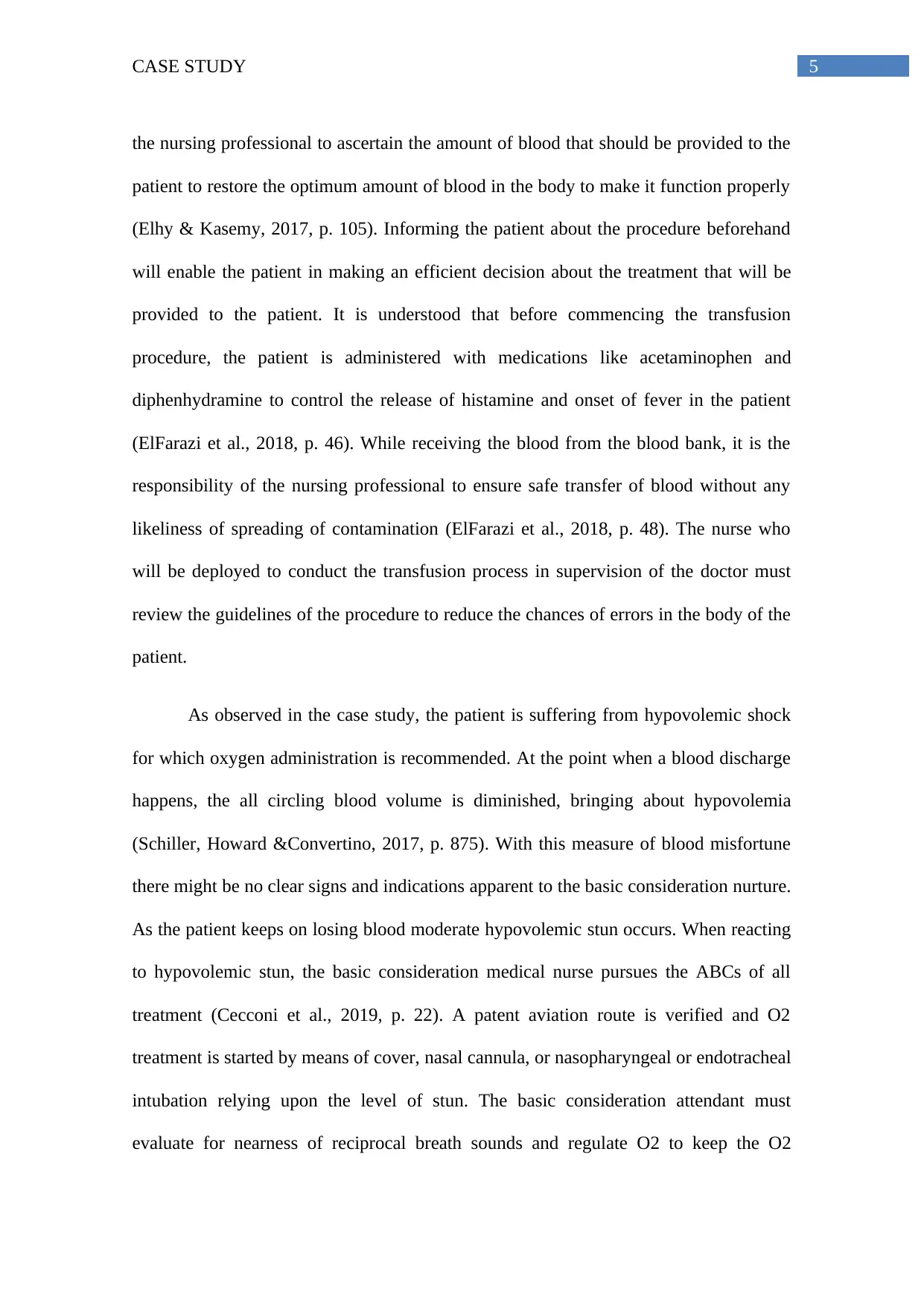
5CASE STUDY
the nursing professional to ascertain the amount of blood that should be provided to the
patient to restore the optimum amount of blood in the body to make it function properly
(Elhy & Kasemy, 2017, p. 105). Informing the patient about the procedure beforehand
will enable the patient in making an efficient decision about the treatment that will be
provided to the patient. It is understood that before commencing the transfusion
procedure, the patient is administered with medications like acetaminophen and
diphenhydramine to control the release of histamine and onset of fever in the patient
(ElFarazi et al., 2018, p. 46). While receiving the blood from the blood bank, it is the
responsibility of the nursing professional to ensure safe transfer of blood without any
likeliness of spreading of contamination (ElFarazi et al., 2018, p. 48). The nurse who
will be deployed to conduct the transfusion process in supervision of the doctor must
review the guidelines of the procedure to reduce the chances of errors in the body of the
patient.
As observed in the case study, the patient is suffering from hypovolemic shock
for which oxygen administration is recommended. At the point when a blood discharge
happens, the all circling blood volume is diminished, bringing about hypovolemia
(Schiller, Howard &Convertino, 2017, p. 875). With this measure of blood misfortune
there might be no clear signs and indications apparent to the basic consideration nurture.
As the patient keeps on losing blood moderate hypovolemic stun occurs. When reacting
to hypovolemic stun, the basic consideration medical nurse pursues the ABCs of all
treatment (Cecconi et al., 2019, p. 22). A patent aviation route is verified and O2
treatment is started by means of cover, nasal cannula, or nasopharyngeal or endotracheal
intubation relying upon the level of stun. The basic consideration attendant must
evaluate for nearness of reciprocal breath sounds and regulate O2 to keep the O2
the nursing professional to ascertain the amount of blood that should be provided to the
patient to restore the optimum amount of blood in the body to make it function properly
(Elhy & Kasemy, 2017, p. 105). Informing the patient about the procedure beforehand
will enable the patient in making an efficient decision about the treatment that will be
provided to the patient. It is understood that before commencing the transfusion
procedure, the patient is administered with medications like acetaminophen and
diphenhydramine to control the release of histamine and onset of fever in the patient
(ElFarazi et al., 2018, p. 46). While receiving the blood from the blood bank, it is the
responsibility of the nursing professional to ensure safe transfer of blood without any
likeliness of spreading of contamination (ElFarazi et al., 2018, p. 48). The nurse who
will be deployed to conduct the transfusion process in supervision of the doctor must
review the guidelines of the procedure to reduce the chances of errors in the body of the
patient.
As observed in the case study, the patient is suffering from hypovolemic shock
for which oxygen administration is recommended. At the point when a blood discharge
happens, the all circling blood volume is diminished, bringing about hypovolemia
(Schiller, Howard &Convertino, 2017, p. 875). With this measure of blood misfortune
there might be no clear signs and indications apparent to the basic consideration nurture.
As the patient keeps on losing blood moderate hypovolemic stun occurs. When reacting
to hypovolemic stun, the basic consideration medical nurse pursues the ABCs of all
treatment (Cecconi et al., 2019, p. 22). A patent aviation route is verified and O2
treatment is started by means of cover, nasal cannula, or nasopharyngeal or endotracheal
intubation relying upon the level of stun. The basic consideration attendant must
evaluate for nearness of reciprocal breath sounds and regulate O2 to keep the O2

6CASE STUDY
immersion >96%. Additionally, the medical caretaker screens the patient for changes in
level of cognizance, which may reflect hypoxia (Pereira & Silva, 2018, p. 36).
Crystalloid arrangements, for example, Ringer's lactate and typical saline, are utilized to
keep up liquid and electrolyte balance during hypovolemic stun. Ringer's lactate, an
isotonic arrangement, attempts to extend blood volume within the sight of blood
misfortune, and the lactate is a cradle within the sight of acidosis.
The patient, Mr Bradman, is a prisoner who has been admitted to the hospital
with a case of severe per rectum bleed. He was admitted under the supervision of a
prison escort.
The most common cause rectal bleeding can be narrowed down to formation of
anal fissures, chronic constipation, haemorrhoids, inflammatory bowel disease or
acquired intestinal infections. Considering that he is a prisoner, contraction of any
infection is highly possible. Upon fluid assessment, it was also found that he has a surge
in the white blood cell count, which could indicate an infection.
Even though the gastrointestinal issues are mostly due to physiological reasons,
it has been observed that the proper functionality of both the psychosocial responses and
gastrointestinal organs are subjected to a unidirectional relationship, where the
psychosocial responses can alter the physiologic processes to an extent (Knippa, Rauen
& Muller, 2019, p. 68). Thus, psychosocial factors like depression, stress, anxiety, can
trigger and modify the functionality of the stomach and the bowels (Drossman, 2016, p.
1263). This often leads to severe cases of chronic constipation, peptic and rectal ulcer
formations, as well as anal fissure formation. Mr Bradman must have garnered
psychosocial factors like stress, anxiety and more, during his stay in the prison. Thus,
immersion >96%. Additionally, the medical caretaker screens the patient for changes in
level of cognizance, which may reflect hypoxia (Pereira & Silva, 2018, p. 36).
Crystalloid arrangements, for example, Ringer's lactate and typical saline, are utilized to
keep up liquid and electrolyte balance during hypovolemic stun. Ringer's lactate, an
isotonic arrangement, attempts to extend blood volume within the sight of blood
misfortune, and the lactate is a cradle within the sight of acidosis.
The patient, Mr Bradman, is a prisoner who has been admitted to the hospital
with a case of severe per rectum bleed. He was admitted under the supervision of a
prison escort.
The most common cause rectal bleeding can be narrowed down to formation of
anal fissures, chronic constipation, haemorrhoids, inflammatory bowel disease or
acquired intestinal infections. Considering that he is a prisoner, contraction of any
infection is highly possible. Upon fluid assessment, it was also found that he has a surge
in the white blood cell count, which could indicate an infection.
Even though the gastrointestinal issues are mostly due to physiological reasons,
it has been observed that the proper functionality of both the psychosocial responses and
gastrointestinal organs are subjected to a unidirectional relationship, where the
psychosocial responses can alter the physiologic processes to an extent (Knippa, Rauen
& Muller, 2019, p. 68). Thus, psychosocial factors like depression, stress, anxiety, can
trigger and modify the functionality of the stomach and the bowels (Drossman, 2016, p.
1263). This often leads to severe cases of chronic constipation, peptic and rectal ulcer
formations, as well as anal fissure formation. Mr Bradman must have garnered
psychosocial factors like stress, anxiety and more, during his stay in the prison. Thus,
Paraphrase This Document
Need a fresh take? Get an instant paraphrase of this document with our AI Paraphraser
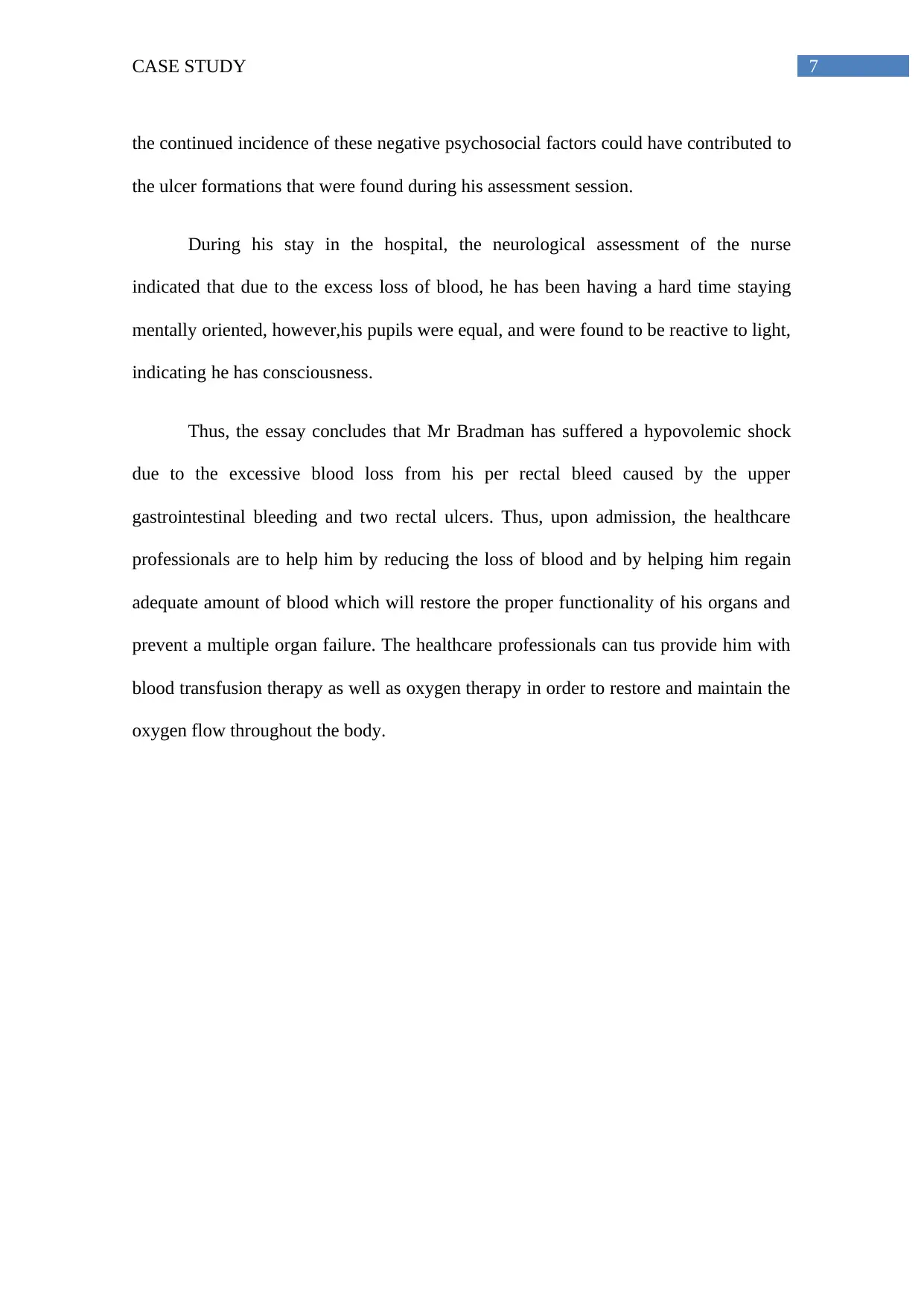
7CASE STUDY
the continued incidence of these negative psychosocial factors could have contributed to
the ulcer formations that were found during his assessment session.
During his stay in the hospital, the neurological assessment of the nurse
indicated that due to the excess loss of blood, he has been having a hard time staying
mentally oriented, however,his pupils were equal, and were found to be reactive to light,
indicating he has consciousness.
Thus, the essay concludes that Mr Bradman has suffered a hypovolemic shock
due to the excessive blood loss from his per rectal bleed caused by the upper
gastrointestinal bleeding and two rectal ulcers. Thus, upon admission, the healthcare
professionals are to help him by reducing the loss of blood and by helping him regain
adequate amount of blood which will restore the proper functionality of his organs and
prevent a multiple organ failure. The healthcare professionals can tus provide him with
blood transfusion therapy as well as oxygen therapy in order to restore and maintain the
oxygen flow throughout the body.
the continued incidence of these negative psychosocial factors could have contributed to
the ulcer formations that were found during his assessment session.
During his stay in the hospital, the neurological assessment of the nurse
indicated that due to the excess loss of blood, he has been having a hard time staying
mentally oriented, however,his pupils were equal, and were found to be reactive to light,
indicating he has consciousness.
Thus, the essay concludes that Mr Bradman has suffered a hypovolemic shock
due to the excessive blood loss from his per rectal bleed caused by the upper
gastrointestinal bleeding and two rectal ulcers. Thus, upon admission, the healthcare
professionals are to help him by reducing the loss of blood and by helping him regain
adequate amount of blood which will restore the proper functionality of his organs and
prevent a multiple organ failure. The healthcare professionals can tus provide him with
blood transfusion therapy as well as oxygen therapy in order to restore and maintain the
oxygen flow throughout the body.
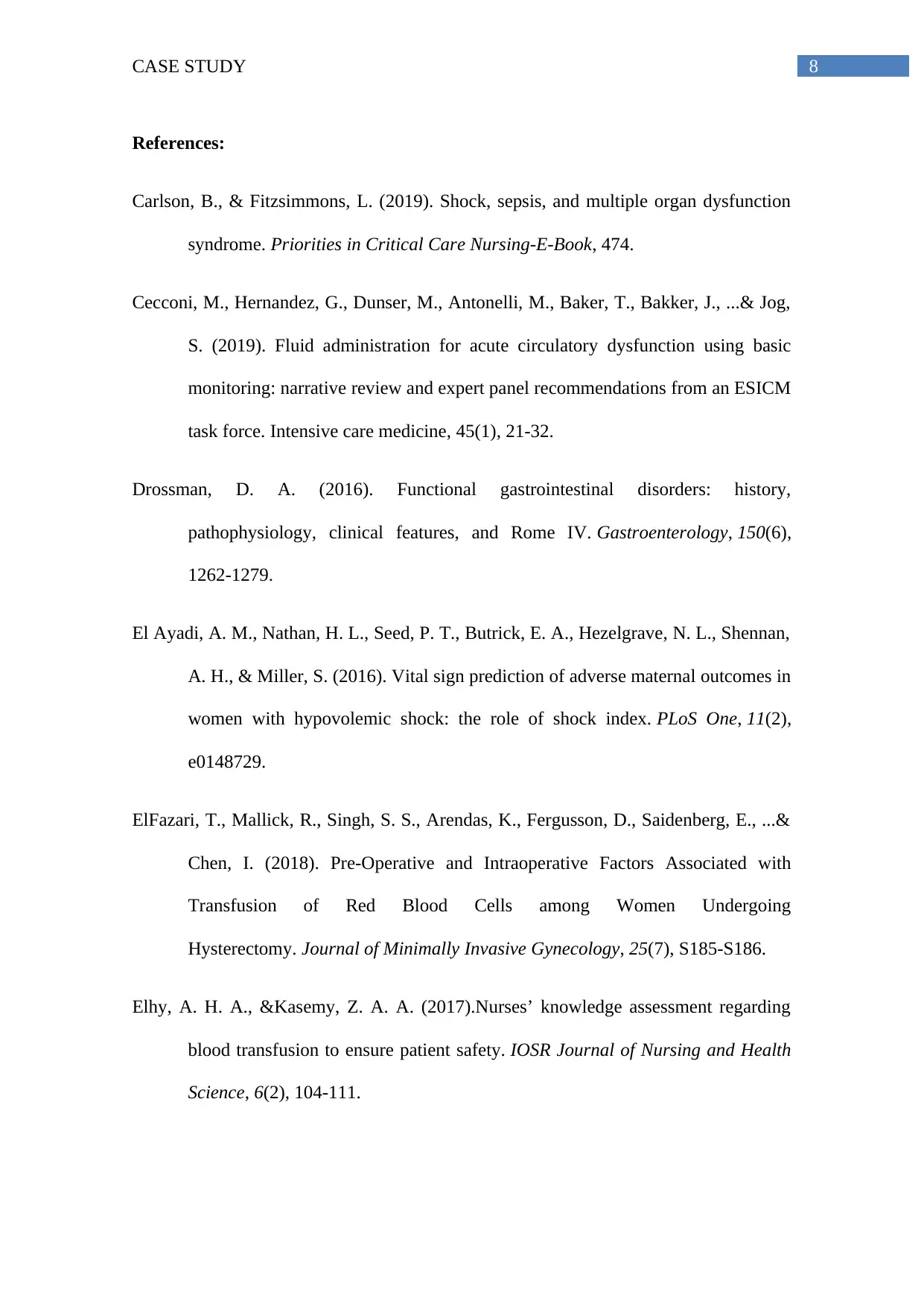
8CASE STUDY
References:
Carlson, B., & Fitzsimmons, L. (2019). Shock, sepsis, and multiple organ dysfunction
syndrome. Priorities in Critical Care Nursing-E-Book, 474.
Cecconi, M., Hernandez, G., Dunser, M., Antonelli, M., Baker, T., Bakker, J., ...& Jog,
S. (2019). Fluid administration for acute circulatory dysfunction using basic
monitoring: narrative review and expert panel recommendations from an ESICM
task force. Intensive care medicine, 45(1), 21-32.
Drossman, D. A. (2016). Functional gastrointestinal disorders: history,
pathophysiology, clinical features, and Rome IV. Gastroenterology, 150(6),
1262-1279.
El Ayadi, A. M., Nathan, H. L., Seed, P. T., Butrick, E. A., Hezelgrave, N. L., Shennan,
A. H., & Miller, S. (2016). Vital sign prediction of adverse maternal outcomes in
women with hypovolemic shock: the role of shock index. PLoS One, 11(2),
e0148729.
ElFazari, T., Mallick, R., Singh, S. S., Arendas, K., Fergusson, D., Saidenberg, E., ...&
Chen, I. (2018). Pre-Operative and Intraoperative Factors Associated with
Transfusion of Red Blood Cells among Women Undergoing
Hysterectomy. Journal of Minimally Invasive Gynecology, 25(7), S185-S186.
Elhy, A. H. A., &Kasemy, Z. A. A. (2017).Nurses’ knowledge assessment regarding
blood transfusion to ensure patient safety. IOSR Journal of Nursing and Health
Science, 6(2), 104-111.
References:
Carlson, B., & Fitzsimmons, L. (2019). Shock, sepsis, and multiple organ dysfunction
syndrome. Priorities in Critical Care Nursing-E-Book, 474.
Cecconi, M., Hernandez, G., Dunser, M., Antonelli, M., Baker, T., Bakker, J., ...& Jog,
S. (2019). Fluid administration for acute circulatory dysfunction using basic
monitoring: narrative review and expert panel recommendations from an ESICM
task force. Intensive care medicine, 45(1), 21-32.
Drossman, D. A. (2016). Functional gastrointestinal disorders: history,
pathophysiology, clinical features, and Rome IV. Gastroenterology, 150(6),
1262-1279.
El Ayadi, A. M., Nathan, H. L., Seed, P. T., Butrick, E. A., Hezelgrave, N. L., Shennan,
A. H., & Miller, S. (2016). Vital sign prediction of adverse maternal outcomes in
women with hypovolemic shock: the role of shock index. PLoS One, 11(2),
e0148729.
ElFazari, T., Mallick, R., Singh, S. S., Arendas, K., Fergusson, D., Saidenberg, E., ...&
Chen, I. (2018). Pre-Operative and Intraoperative Factors Associated with
Transfusion of Red Blood Cells among Women Undergoing
Hysterectomy. Journal of Minimally Invasive Gynecology, 25(7), S185-S186.
Elhy, A. H. A., &Kasemy, Z. A. A. (2017).Nurses’ knowledge assessment regarding
blood transfusion to ensure patient safety. IOSR Journal of Nursing and Health
Science, 6(2), 104-111.
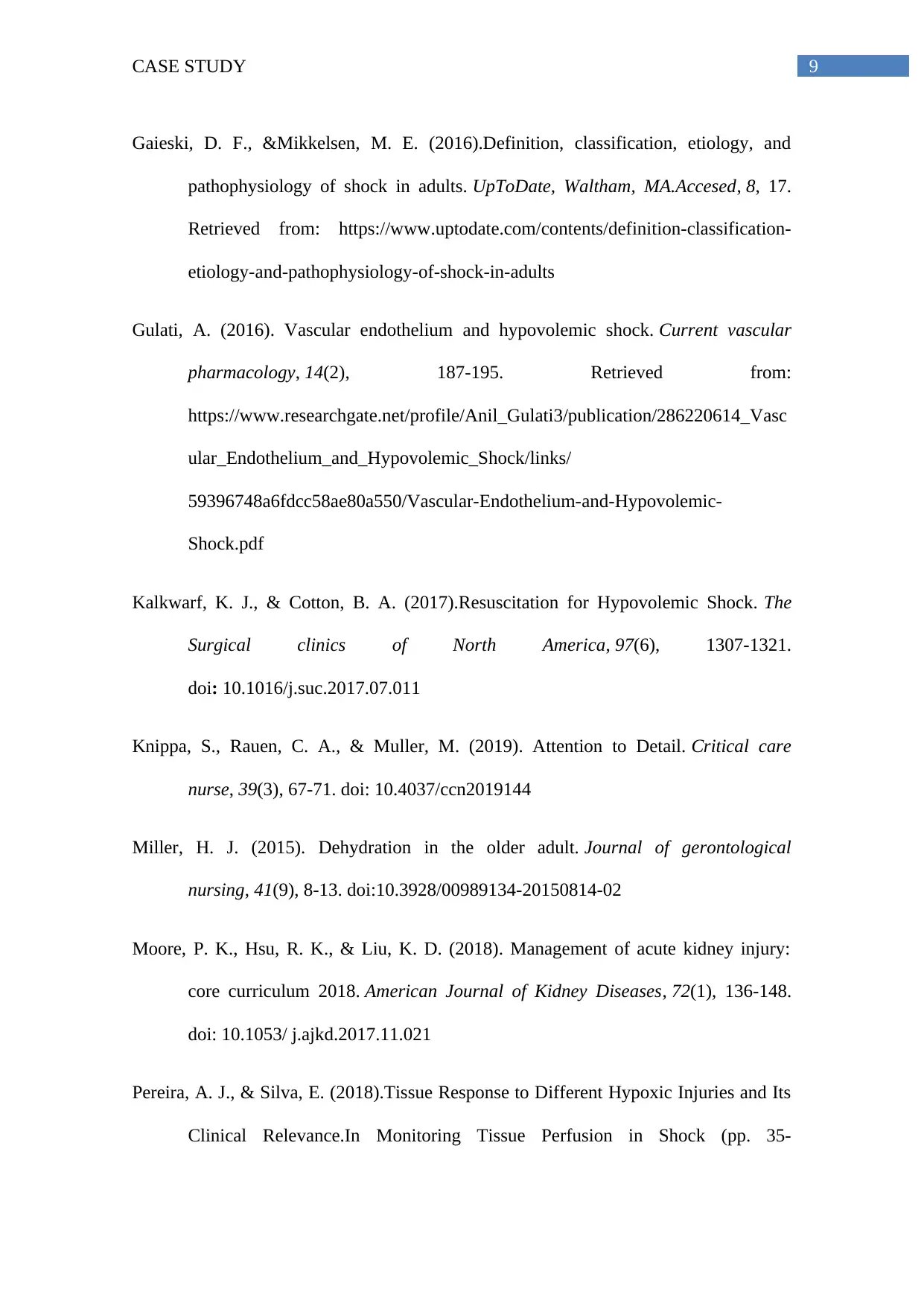
9CASE STUDY
Gaieski, D. F., &Mikkelsen, M. E. (2016).Definition, classification, etiology, and
pathophysiology of shock in adults. UpToDate, Waltham, MA.Accesed, 8, 17.
Retrieved from: https://www.uptodate.com/contents/definition-classification-
etiology-and-pathophysiology-of-shock-in-adults
Gulati, A. (2016). Vascular endothelium and hypovolemic shock. Current vascular
pharmacology, 14(2), 187-195. Retrieved from:
https://www.researchgate.net/profile/Anil_Gulati3/publication/286220614_Vasc
ular_Endothelium_and_Hypovolemic_Shock/links/
59396748a6fdcc58ae80a550/Vascular-Endothelium-and-Hypovolemic-
Shock.pdf
Kalkwarf, K. J., & Cotton, B. A. (2017).Resuscitation for Hypovolemic Shock. The
Surgical clinics of North America, 97(6), 1307-1321.
doi: 10.1016/j.suc.2017.07.011
Knippa, S., Rauen, C. A., & Muller, M. (2019). Attention to Detail. Critical care
nurse, 39(3), 67-71. doi: 10.4037/ccn2019144
Miller, H. J. (2015). Dehydration in the older adult. Journal of gerontological
nursing, 41(9), 8-13. doi:10.3928/00989134-20150814-02
Moore, P. K., Hsu, R. K., & Liu, K. D. (2018). Management of acute kidney injury:
core curriculum 2018. American Journal of Kidney Diseases, 72(1), 136-148.
doi: 10.1053/ j.ajkd.2017.11.021
Pereira, A. J., & Silva, E. (2018).Tissue Response to Different Hypoxic Injuries and Its
Clinical Relevance.In Monitoring Tissue Perfusion in Shock (pp. 35-
Gaieski, D. F., &Mikkelsen, M. E. (2016).Definition, classification, etiology, and
pathophysiology of shock in adults. UpToDate, Waltham, MA.Accesed, 8, 17.
Retrieved from: https://www.uptodate.com/contents/definition-classification-
etiology-and-pathophysiology-of-shock-in-adults
Gulati, A. (2016). Vascular endothelium and hypovolemic shock. Current vascular
pharmacology, 14(2), 187-195. Retrieved from:
https://www.researchgate.net/profile/Anil_Gulati3/publication/286220614_Vasc
ular_Endothelium_and_Hypovolemic_Shock/links/
59396748a6fdcc58ae80a550/Vascular-Endothelium-and-Hypovolemic-
Shock.pdf
Kalkwarf, K. J., & Cotton, B. A. (2017).Resuscitation for Hypovolemic Shock. The
Surgical clinics of North America, 97(6), 1307-1321.
doi: 10.1016/j.suc.2017.07.011
Knippa, S., Rauen, C. A., & Muller, M. (2019). Attention to Detail. Critical care
nurse, 39(3), 67-71. doi: 10.4037/ccn2019144
Miller, H. J. (2015). Dehydration in the older adult. Journal of gerontological
nursing, 41(9), 8-13. doi:10.3928/00989134-20150814-02
Moore, P. K., Hsu, R. K., & Liu, K. D. (2018). Management of acute kidney injury:
core curriculum 2018. American Journal of Kidney Diseases, 72(1), 136-148.
doi: 10.1053/ j.ajkd.2017.11.021
Pereira, A. J., & Silva, E. (2018).Tissue Response to Different Hypoxic Injuries and Its
Clinical Relevance.In Monitoring Tissue Perfusion in Shock (pp. 35-
Secure Best Marks with AI Grader
Need help grading? Try our AI Grader for instant feedback on your assignments.

10CASE STUDY
48).Springer, Cham. Retrieved from:
https://link.springer.com/chapter/10.1007/978-3-319-43130-7_4
Schiller, A. M., Howard, J. T., &Convertino, V. A. (2017). The physiology of blood
loss and shock: New insights from a human laboratory model of hemorrhage.
Experimental Biology and Medicine, 242(8), 874-883.
doi: 10.1177/1535370217694099
Wang, J., Liang, T., Louis, L., Nicolaou, S., & McLaughlin, P. D. (2013). Hypovolemic
shock complex in the trauma setting: a pictorial review. Canadian Association of
Radiologists Journal, 64(2), 156-163.
doi: https://doi.org/10.1016/j.carj.2013.03.002
48).Springer, Cham. Retrieved from:
https://link.springer.com/chapter/10.1007/978-3-319-43130-7_4
Schiller, A. M., Howard, J. T., &Convertino, V. A. (2017). The physiology of blood
loss and shock: New insights from a human laboratory model of hemorrhage.
Experimental Biology and Medicine, 242(8), 874-883.
doi: 10.1177/1535370217694099
Wang, J., Liang, T., Louis, L., Nicolaou, S., & McLaughlin, P. D. (2013). Hypovolemic
shock complex in the trauma setting: a pictorial review. Canadian Association of
Radiologists Journal, 64(2), 156-163.
doi: https://doi.org/10.1016/j.carj.2013.03.002
1 out of 11
Related Documents
Your All-in-One AI-Powered Toolkit for Academic Success.
+13062052269
info@desklib.com
Available 24*7 on WhatsApp / Email
![[object Object]](/_next/static/media/star-bottom.7253800d.svg)
Unlock your academic potential
© 2024 | Zucol Services PVT LTD | All rights reserved.





